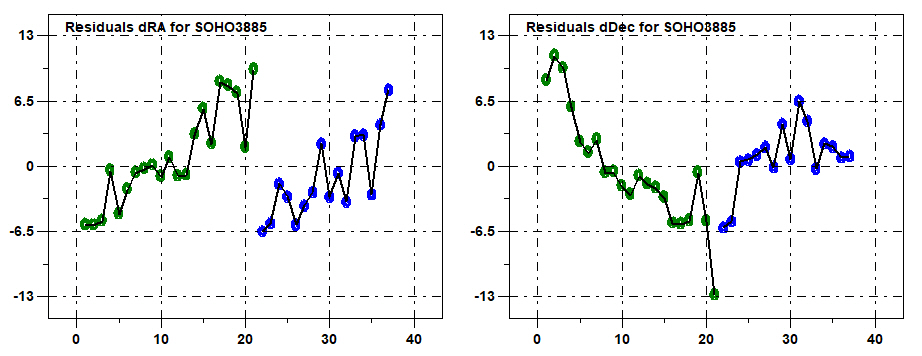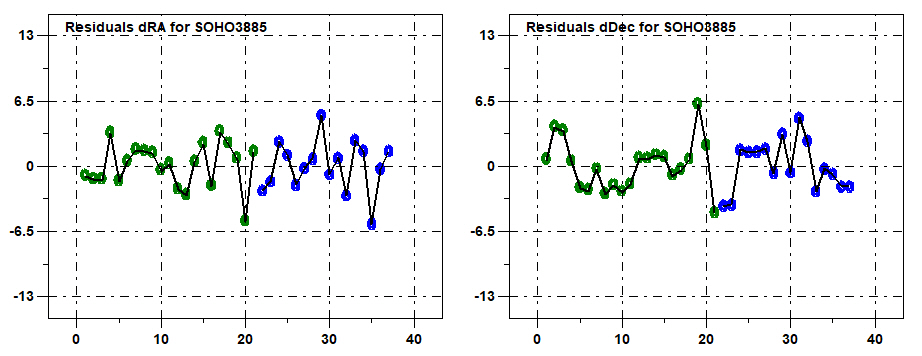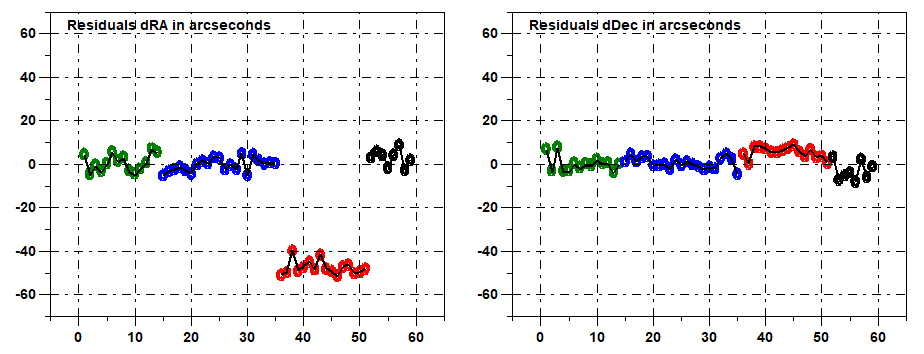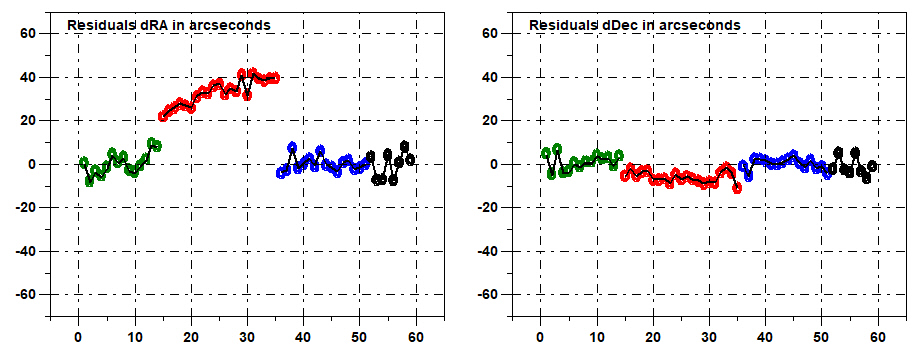The discovery of the "second
Kracht group"
[This page shows how the term
"Kracht2 group" came into being. The Marsden, Meyer and
Kracht comet groups were found 2002 from observations with SOHO
LASCO. The initial announcement on IAUC 7832 of the Meyer group
showed only four members of this new group, but until now (2015
May) more than 100 members have been found. The "new
group" announced on IAUC 8340 in 2004 had initially only
three comets and I used the name "Kracht2 group" for
the "new group". Later Karl Battams used this name for
the description of the SOHO comets at the sungrazer site and
others used this name also. But no new comets have been found to
belong to this "new group". C/2002 R5 had split in two
parts when it returned in 2008 and C/1999 R1 is identical with
C/2003 R5, so there are still (as of May 2015) only three comets.
The expectation from 2004 for a new group did not come true.]
SOHO's images have been posted on its
website since 1999 May. Terry Lovejoy was the first internet user
to discover a SOHO comet in 1999 August. Five weeks later, he
found a non-Kreutz group comet. It was designated C/1999 R1 (MPEC 1999-R19).
Brian Marsden wrote (IAUC 7251):
COMET C/1999 R1 (SOHO)
D. A. Biesecker, SM&A Corporation and Goddard Space Flight
Center,
reports observations of what is presumably a comet, not a Kreutz
sungrazer, discovered by T. Lovejoy in SOHO/LASCO C3 data and
later
also recognized in earlier C2 data. Astrometry and orbital
computations
are given on MPEC 1999-R19. Biesecker also provides the following
LASCO magnitudes, reduced using the Hipparcos Input Catalogue:
Sept. 5.47 UT, 6.6; 5.53, 6.5; 5.57, 6.4; 5.61, 6.3; 5.65, 6.2;
5.70, 6.2; 5.78, 6.4; 5.82, 6.4; 5.86, 6.7; 5.90, 6.9; 5.99, 6.9;
6.07, 7.4; 6.15, 7.4. No tail was detected.
Three years later, Rob Matson found
another non-Kreutz group comet first in C2 images and later in C3
images. Only one hour after he had posted his find, I wrote:
Congrats!
It moves very close to the apparent track
of C/1999 R1 with the right speed.
So it's certainly related to C/1999 R1
and there could evolve another new group.
The comet was designated C/2002 R5. Brian Marsden wrote (MPEC 2002-S35, IAUC 7984):
C/2002 R5 appears to be related to C/1999 R1, a point first made by R. Kracht;
Finally, Kazimieras Cernis found another non-Kreutz group comet in C2 images of 2003 September 08 and later in C3 images. I wrote:
Congrats Kazimieras!
The apparent track (and velocity) in C2 is similar to the
tracks (and velocities) of the low inclination SOHO comets
C/1999 R1 and C/2002 R5.
Derek Hammer had left in 2003 August and so there was nobody to measure the positions of the new comet.
I derived a prelininary orbit from my own measurements and sent it to Brian Marsden. The orbit was similar to the
orbits of C/1999 R1 and C/2002 R5.
In 2003 December Karl Battams began measuring and reporting the SOHO comets to CBAT. Karl had a lot of comets to catch up on and
measured Kazimieras comet 2004 April 30. The comet was designated C/2003 R5 (MPEC 2004-J59) May 13. Brian Marsden wrote:
R. Kracht remarked already last September on the similarity of the
motion of what is now called C/2003 R5 to the motions of his proposed pair
C/1999 R1 and C/2002 R5 (see MPEC 2002-S35), fortuitously observed at the
same time of the year. The above orbit is essentially identical with that of
C/1999 R1 on MPEC 1999-R19.
On 2004 May 17 the new group was announced by Daniel Green (IAUC 8340):
C/2003 R5 belongs to a new group that certainly includes
C/1999 R1 and probably includes C/2002 R5.
Orbital elements of the second Kracht group comets compared with those of the other new groups (2004 July):
| Designation |
T |
q |
peri |
node |
incl |
L |
B |
| C/1999 R1 |
1999 Sep 05.52 |
0.0565 |
43.74 |
5.22 |
13.69 |
48.1 |
9.4 |
| C/2002 R5 |
2002 Sep 5.79 |
0.0472 |
45.38 |
13.40 |
14.06 |
57.9 |
10.0 |
| C/2003 R5 |
2003 Sep 8.81 |
0.0569 |
43.55 |
5.05 |
13.59 |
47.8 |
9.3 |
| weighted mean |
|
0.0545 |
44.0 |
7.1 |
13.7 |
50.3 |
9.5 |
| Kracht group |
|
0.0474 |
55.8 |
46.3 |
13.4 |
101.4 |
10.9 |
| Marsden group |
|
0.0486 |
23.4 |
81.1 |
27.4 |
102.3 |
10.4 |
| Meyer group |
|
0.0356 |
57.1 |
73.3 |
72.4 |
98.3 |
53.1 |
The weights are the lengths of the observation times
(last obs - first obs).
Sebastian Hönig has sucessfully linked C/1999 R1 =
C/2003 R5 (Identification
of a new short-period comet near the sun).
He predicts the next return for about 2007 September 11.
Integrating his orbit backwards with Solex 9.1, I have
found these approximate perihelion dates:
1995 September 04 (before SOHO and after SMM)
1991 August 28 (before SOHO and after SMM)
1987 August 19 (SMM images available)
Unfortunately the path of this comet is outside the SOHO LASCO
C2 field in mid-August.The C2 FOV is about 3.5 x 3.5 degrees.The
SMM FOV is about 3.0 x 3.0 degrees (four quadrants around the
sun, each measuring 1.5 x 1.5 degrees).
The returns of C/1999 R1 = C/2003 R5
Bo Zhou found the returning comet in
LASCO C2 images of 2007 September 10 19:31 - 21:30 UTC moving
very close to the prediction of Sebastian Hönig. Later, I found
it entering the C2 field at 2007 September 10 06:54 with an
approximate magnitude of mag 9. It was visible in C3 until about
2007 Sep 11 06:18 UTC. It reached mag 5.5 shortly after
perihelion in C3. I could not find it in STEREO SECCHI COR2A
images close to peak brightness though they showed stars to mag
10. This is a strong argument for the cometary nature of this
object.
| Designation |
T |
q |
peri |
node |
incl |
L |
B |
| P/1999 R1 |
1999 Sep 05.52 |
0.0564 |
43.34 |
5.39 |
13.68 |
47.9 |
9.3 |
| P/2003 R5 |
2003 Sep 8.82 |
0.0569 |
43.62 |
5.09 |
13.60 |
47.9 |
9.3 |
| P/2007 R5 |
2007 Sep 11.32 |
0.0537 |
48.57 |
0.05 |
12.64 |
47.9 |
9.4 |
| P/2011 |
2011 Sep 07.10 |
0.0532 |
48.55 |
0.08 |
12.65 |
47.9 |
9.4 |
Elements from MPEC
2007-S16, Integration to 2011 with Solex.
The orbital elements (peri, node, incl) changed quite a bit
between 2003 and 2007. This is due to a moderately close approach
(<1.4 AU) to Jupiter in May/June 2006.
The comet was observed to be a bit brighter (mag 5.5 instead of
mag 6) than at his previously observed two returns.
It will be interesting to see the evolution of this comet.
Will it show fragments? Unfortunately, there is only one
instrument at this time to show the comet: SOHO LASCO shows the
comet close to its perihelion times. It could be lost, if SOHO
LASCO will not be operating 2011 September 06/07.
Perhaps Earth based instruments can image the comet, but it will
be quite faint at the larger solar elongations.
The perihelion dates have not much changed with the
new orbit from MPEC 2007-S16:
1995 September 03
1991 August 26
1987 August 17
1983 August 08
Bo Zhou also found the returning comet in LASCO
C2 images of 2011 September 06 13:25 - 13:48 UTC. Later that day
Michal Kusiak detected the comet in LASCO C3 images from 20:30
and 20:42 UTC. On September 09 the comet was also detected in
STEREO SECCHI HI1A and HI1B images by Alan Watson. Man-To Hui
measured the HI1A positions the same day and wrote:
"Astrometrica seems not good at finding the optcenter of a
faint object even when being forced to do such work.". I had
measured the C3 positions of September 06 20:18 - 22:30 UTC and
could link them with the observations from 1999. 2003 and 2007.
When I added Man-To's HI1A positions they showed a strong trend
in the residuals, so I could not include them into the solution.
From the C2 and C3 observations 1999 - 2011 I got these orbital
elements (integration to 2015 with Solex):
| Designation |
T |
q |
peri |
node |
incl |
L |
B |
| P/1999 R1 |
1999 Sep 05.52 |
0.0565 |
43.36 |
5.30 |
13.74 |
47.8 |
9.4 |
| P/2003 R5 |
2003 Sep 08.82 |
0.0571 |
43.64 |
5.00 |
13.66 |
47.8 |
9.4 |
| P/2007 R5 |
2007 Sep 11.32 |
0.0539 |
48.57 |
359.96 |
12.69 |
47.8 |
9.5 |
| P/2011 R |
2011 Sep 07.12 |
0.0533 |
48.56 |
359.99 |
12.70 |
47.8 |
9.5 |
| P/2015 R |
2015 Sep 04.07 |
0.0538 |
48.97 |
359.57 |
12.62 |
47.8 |
9.5 |
A very similar prediction for 2015 is at NK
2328.
P/1999 R1 = 2003 R5 = 2007 R5 has returned in
2011 (P/2011 R4) and in 2015, it had been numbered as 322P/SOHO
in June 2015.
The return of C/2002 R5 = C/2008 L6 and
L7
2008 June 10 I found a comet in LASCO C2 which
moved on the track of C/2002 R5. It was accompanied by a small
leading fragment. I could link the observations of the new comet
with those of C/2002 R5. The orbital period is 5.8 years, similar
the orbital periods of the Kracht and Marsden group comets.
2008 July 24 Brian Marsden issued MPEC 2008-O23,
in which he wrote:
Comets C/2008 L6 and L7
appear to be members of the "Kracht 2" Group, and
R. Kracht suggests that they represent a return of comet C/2002
R5 (cf. MPEC
2002-S35). The 15-deg shift in the line of nodes actually
supports the
likely correctness of this linkage, as it is consistent with the
comet's
passage within 1.1 AU of Jupiter in Jan. 2007.
Z. Sekanina derived the time of
breakup of C/2002 R5 into its fragments C/2008 L6 and C/2008 L7
as most probably between 2 and 10 weeks before the 2002
perihelion and gave an elliptical solution for C/2008 L7 (IAUC
8983, 2008 September 28). The perihelion times of L6 and L7
differ by 18 minutes.
| Designation |
T |
q |
peri |
node |
incl |
L |
B |
| C/2002 R5 |
2002 Sep 05.79 |
0.0472 |
45.76 |
13.34 |
14.17 |
58.2 |
10.1 |
| C/2008 L6 |
2008 Jun 10.18 |
0.0460 |
58.90 |
359.83 |
12.15 |
58.2 |
10.4 |
| C/2008 L7 |
2008 Jun 10.17 |
0.0460 |
58.93 |
359.80 |
12.15 |
58.2 |
10.4 |
The previous perihelion of C/2002 R5 = 2008 L6
was 1996 November 25.3. The apparent path crosses the C2 field
from about November 25.1 - 25.6, but the comet was not found in
these images.
NK 2164 predicted the next
perihelion of C/2008 L6 for 2014 March 14.98. Zhijian Xu found
the comet already 2014 March 07 in LASCO C2 images 04:17 - 05:00
UTC, seven days earlier than expected. The small, leading
fragment from 2008 was now trailing by 2.6 hours. The new
observations could be linked with those of 2002 and 2008 with A2
= -0.1012 (L6) and A2 = -0.0973 (L7). Orbital elements for C/2002
R5 = 2008 L6 = 2014-ahead:
| Designation |
T |
q |
peri |
node |
incl |
a |
e |
P |
L |
B |
| C/1996 |
1996 Nov 18.15 |
0.0480 |
45.47 |
13.61 |
13.74 |
3.23294 |
0.98516 |
5.813 |
58.2 |
9.7 |
| C/2002 R5 |
2002 Sep 05.79 |
0.0473 |
45.73 |
13.31 |
14.14 |
3.22416 |
0.98532 |
5.789 |
58.2 |
10.1 |
| C/2008 L6 |
2008 Jun 10.18 |
0.0461 |
58.93 |
359.73 |
12.12 |
3.21235 |
0.98565 |
5.758 |
58.1 |
10.4 |
| C/2014 a |
2014 Mar 07.64 |
0.0452 |
59.36 |
359.28 |
12.07 |
3.20176 |
0.98589 |
5.729 |
58.1 |
10.4 |
| C/2019 |
2019 Nov 20.82 |
0.0433 |
69.68 |
348.86 |
11.28 |
3.18475 |
0.98640 |
5.684 |
58.2 |
10.6 |
This solution has close approaches to Jupiter
with 1.078 au on 2007 January 07 and with 1.251 au on 2018
September 29.
The search for the apparition of 1996 November
is difficult (now shifted from November 25 to November 18).
Usually there is only one image per hour and the comet is moving
with about 80 pixels/h in LASCO C2. And for November 21, 22, 23,
24 there are only 4, 2, 0, 8 C2 images per day. A new search in
images from November 17 to December 02 found nothing. The comet
may have been too faint to detect with LASCO C2 before it split
in 2002 or it passed through the field November 21-24, when there
were too few images to detect it.
Orbital evolution of
P/2007 R5 and C/2008 L6
Light curves of the
"Kracht2 group" comets
Update 2019 June 20
I have asked Zdenek Sekanina if it
is possible that the leading component in 2008 could be the
trailing component in 2014 and vice versa. He answered that this
is possible under some conditions at fragmentation, but wanted me
to do the orbital computations again without using the (inferior)
C3 observations. My result of these computations show that the
leading component in 2008 was the leading component in 2014. So
the components did not change places, but the brighter, trailing
component in 2008 (C/2008 L6) was the darker, trailing component
in 2014.
This result is confirmed by Karl
Battam's more extensive measurements of the fragments from 2014,
which I have received in 2019 June. Using all available C2 and C3
observations and weighting them according to pixel size (12"
and 55") I finally got these results:
Orbital elements for C/2002 R5 =
2008 L6 = 2014-behind (SOHO-2712) with A2 = -1.005*10-9:
| Designation |
T |
q |
peri |
node |
incl |
a |
e |
P |
L |
B |
| C/1996 |
1996 Nov 18.204 |
0.0480 |
45.53 |
13.51 |
14.19 |
3.23309 |
0.98516 |
5.813 |
58.14 |
10.08 |
| C/2002 R5 |
2002 Sep 05.794 |
0.0473 |
45.79 |
13.20 |
14.14 |
3.22411 |
0.98532 |
5.789 |
58.11 |
10.08 |
| C/2008 L6 |
2008 Jun 10.181 |
0.0461 |
59.01 |
359.62 |
12.11 |
3.21242 |
0.98565 |
5.758 |
58.05 |
10.36 |
| C/2014 behind |
2014 Mar 07.744 |
0.0452 |
59.43 |
359.16 |
12.07 |
3.20203 |
0.98588 |
5.730 |
58.03 |
10.37 |
| C/2019 |
2019 Nov 21.080 |
0.0434 |
69.81 |
348.68 |
11.28 |
3.18261 |
0.98638 |
5.678 |
58.13 |
10.58 |
This solution has close approaches
to Jupiter with 1.079 au on 2007 January 07 and with 1.249 au on
2018 September 29.
According to this solution the
darker, leading component in 2008 (C/2008 L7) was the brighter,
leading component in 2014. Orbital elements for C/2002 R5 = 2008
L7 = 2014-ahead (SOHO-2673) with A2 = -9.495*10-10:
| Designation |
T |
q |
peri |
node |
incl |
a |
e |
P |
L |
B |
| C/1996 |
1996 Nov 18.693 |
0.0479 |
46.16 |
13.33 |
14.18 |
3.23364 |
0.98517 |
5.815 |
58.30 |
10.17 |
| C/2002 R5 |
2002 Sep 05.800 |
0.0473 |
46.43 |
13.02 |
14.12 |
3.22366 |
0.98533 |
5.788 |
58.57 |
10.18 |
| C/2008 L7 |
2008 Jun 10.172 |
0.0460 |
59.53 |
359.55 |
12.16 |
3.21206 |
0.98567 |
5.757 |
58.51 |
10.46 |
| C/2014 ahead |
2014 Mar 07.642 |
0.0451 |
59.96 |
359.10 |
12.11 |
3.20185 |
0.98591 |
5.729 |
58.50 |
10.47 |
| C/2019 |
2019 Nov 21.337 |
0.0433 |
69.98 |
348.98 |
11.36 |
3.18445 |
0.98641 |
5.683 |
58.59 |
10.67 |
This solution has close approaches
to Jupiter with 1.085 au on 2007 January 12 and with 1.268 au on
2018 October 03.
This solution for C/2002 R5 = 2008
L7 = SOHO-2673 shows distinct systematic trends in the residuals
of 2014. The same is true for C/2002 R5 = 2008 L6 = SOHO-2673
with reversed trends in 2014.
SOHO-2712 can also be linked with
C/2002 R5 = 2008 L7 with T = 2019 December 29.14.
Update 2020 October 23
Fragments of P/2002 R5 were
observed with SOHO/LASCO on 2019 Nov 27, Dec 06, Dec 13 and Dec
20. A new orbital solution for the brightest fragment is here (Item 4).
Update 2023 January 17
Hanjie Tan has
posted on 2022 August 07 his discovery of two Kracht 2 group
comets in archival C2 images of 2014 March 05 and 07. Now we have
four fragments in 2014 and four fragments in 2019. Orbital
solutions for the three smaller fragments are here (Items C, D, E). The next
perihelia are in 2025 August to October.
Update
2025 October 20
Five fragments of
P/2002 R5 were found on 2025 August 15, 21, 22, 26 and 30 in
images of CCOR1. When I tried to link them with the previous seen
fragments, I realized that the residuals of SOHO-3885 have large
trends. I had noticed this already in 2020 February and Karl
Battams remeasured SOHO-3885 with the SOHO clock corrections
applied to the data.The residuals looked a bit better, but the
trends were still there.

Residuals of the remeasurements in arcseconds (pixelsize is 12
arcseconds)
Measurements 1-21 are before solar conjunction, measurement 22-37
are after solar conjunction (there is a gap of 5.2 hours between
the first and the second set of the measurements).
When I tried to
link SOHO-3885 to the new fragments I could use only the first 21
measurements (before conjunction). Those measurements gave small
residuals but the measurements post conjunction did not fit.
Solving the orbits separately for the two sets of measurements
gave this result:

Residuals of the remeasurements in arcseconds, before (green) and
after (bkue) conjunction
The residuals post
conjunction are now as good as the residuals before conjunction
and both show no trends. This leads to the conclusion that
SOHO-3885 is not one but two comets.3885A before solar
conjunction and 3885B after solar conjunction. We have then not
four but five fragments in 2019 (as in 2025). This result is
confirmed by successfully linking the two parts of SOHO-3885 with
the two fragments of 2025 August 21/22 (measured by me) and
SOHO-2712 in 2014. These solutions differ by only 0.04 hours in
their times of perihelion. The two fragments moved with 70 .. 80
pixel/hour through the SOHO LASCO C2 field of view. So they were
separated by about three pixels. Both fragments appear stellar,
not elongated and with no companion.

Residuals of the solution from SOHO-2712 = SOHO-3885A = 20250821
(green, blue, black dots)
Red dots show the residuals of SOHO-3885B (after solar
conjunction) from this solution

Residuals of the solution from SOHO-2712 = SOHO-3885B = 20250821
(green, blue, black dots)
Red dots show the residuals of SOHO-3885A (before solar
conjunction) from this solution
Only the first
fragment was visible before solar conjunction and the second
fragment was only visible after solar conjunction. This reminds
me on the Marsden group comet pair SOHO-413/414, which was
observed also in LASCO C2. The first fragment was visible on 1999
August 15 from 00:06 - 05:30 UTC and the second fragment was
visible from 05:30 - 14:06 UTC. In the image from 05:30 they were
separated by 67 pixels, their perihelia were separated by 1,2
hours. Compared to the two fragments of SOHO-3885 the separation
of SOHO-413 and -414 was much greater and it was immediately
clear that these are separate fragments. But as with SOHO-3885
the second fragment was visible after the first fragment had
disappeared..
So far we have
this split history of P/2002 R5:
P/2002 R5 split into P/2008 L6 and a smaller piece P/2008 L7
P/2008 L7 split into SOHO-2712, 4836, 4837 (these fragments were
observed in 2014)
SOHO-2712 split in SOHO-3882A and 3885B (observed in 2019)



